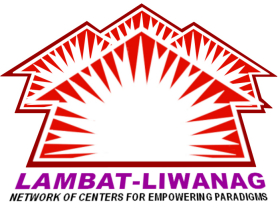|
13
|
13. Mutual Enrichment of Families and
Friendships.
|
 Promotion of consciousness on families and friendships as synergies
Promotion of consciousness on families and friendships as synergies
 Consciousness of families and friendships as vital building blocks of
bigger (community, national and international) synergies
Consciousness of families and friendships as vital building blocks of
bigger (community, national and international) synergies
 Repudiation of sub-cultures for small-group separativeness, like
rumble-prone fraternities, clannishness or tribal mentality,
sectarianism, and 'pakikisama' mainly for negative actions and behavior.
Repudiation of sub-cultures for small-group separativeness, like
rumble-prone fraternities, clannishness or tribal mentality,
sectarianism, and 'pakikisama' mainly for negative actions and behavior.
 Adoption of family interaction ideals in friendships
Adoption of family interaction ideals in friendships
* Adoption of healthy friendship dynamics in family relations
 Families and friendship circles as natural groupings for light-sharing
ethics.
Families and friendship circles as natural groupings for light-sharing
ethics.
 Marriage as ideal meeting point of synergism paradigms in Friendships
and in Family life-- discernment for choice of partner, real preparation
for marriage, continuing development and enjoyment of holistic romance
between the partners during decades of marriage to further develop its
inner strength.
Marriage as ideal meeting point of synergism paradigms in Friendships
and in Family life-- discernment for choice of partner, real preparation
for marriage, continuing development and enjoyment of holistic romance
between the partners during decades of marriage to further develop its
inner strength.
|
THE 15 EMPOWERING PARADIGMS: |
1.
Total Human Development and Harmony Through
Synergism
2.
Holistic Health Care and Medicine
3.
Deep Ecology and Harmony with Nature
4.
Sense of History and Sense of Mission
5.
Civics and Democratic Governance
6.
Culture as Community Creativity
7.
Light-Seeking and Light-Sharing Education
8.
Gender Sensitivity, Equality & Harmony
9.
Reconstructive/Restor-ative Justice
10.
Associative Economics, Social Capital and
Sustainable Development
11.
Synergetic Leadership and Organizations
12.
Appropriate/Adaptive Technology
13.
Mutual Enrichment of Families and Friendships
14.
Human Dignity and Human Harmony: Human Rights and
Peace
15.
Aesthetics Without Boundaries: 'Art from the
Heart'
. |

The Parent Show*
By Christine Fischer
Reprinted from Readers Digest, June 2003
SHAKESPEARE, apparently had it right. All the world is a stage. “You are actors. And the stage is your family,” says Claude Guldner, a marriage and family therapist and professor emeritus at the University of Guelph in Ontario, Canada. “The kids see everything on that stage.”
For better or worse, our day-to-day intereactions with our spouse – such things as decision-making, conflict and displays of afdfection – slowly construct what Judith Siegel calls our children’s “blueprint for intimacy.”
Siegel is the author of What Children from Their Parents’ Marriage and a professor at the Ehrenkranz School of Social Work in New Yourk University. She says research shows that this primary model of intimacy makes a lasting impression on kids. “In a problematic marriage, children might develop behavioral problems or health problems such as gaining weight or headaches,” says Siegel. Their gradses may drop, their personalities change.
And kids can carry the burden of marital difficulties into their own adult relationships. “Not only can kids take on their parents’ unfinished business, but this can be passed down, generation after generation,” Guldner explains.
There’s a positive flip side to this, of course. “When we look at children who come from families where there are healthy marital relationships, we see it reflected in their physical health as well as their ability to function well socially and academically,” says Jane Margles, a clinical psychologist at York University in Toronto.
Experts and parents agree that the bedrock of a healthy marriage is mutual respect. “It’s always been very important to us that we don’t cut each other down in front of the kids,” says Jasmine Burns.” She and her husband, David, will take one another aside to iron out disagereements instead of doing it in full view of their children.
Saving criticism until after the fact can also work. “Many times I think my husband is too hard on the boys,” says Ivanna McNeal, “But I let him handle the situation, and then when we are alone, I let him know what I think.”
Siegel also urges parents to be careful when and where they chose to blow off steam about their spouse’s shortcomings. “People sometimes complain to their family and friends about their partner on the telephone, not realizing that their children are listening,” she explains.
It takes maturity, however, to realize that thew long-term goal of mutual respect is more important than minor victories. Catherine Lee, professor pf clinical psychology at the University of Ottawa, urges parents to see their marriage through their children’s eyes. “What do you want to to teach them about how to treat the opposite sex, how to face challenges or cope with feelings?”
Guldner stresses that this big-picture viewpoint is critical. “It’s through differences that we grow. When a husband and wife create space for each other’s ideas, then kids learn.”
Though parents Judith Cullington and Glen Okrainetz have never sat down and explained their decision-making processes, their sons have been aware of it from an early age. When the boys, now 11 and 14, question rules or major decisions, they’re aweare that both parents’ views carry equal weight. As Okrainetz explains, “They’ll quite often say, ‘You may want to talk to Mum about this first, but here’s what I want to do.”
As they grow, kids absorb decision-making techniques simply by overhearing conversations, says Lee. A discussion about where and when to go for a holiday, for example, can illustrate planning and compromise. Normal, everyday life-managing discussions, of course, can sometimes develop into heated exchanges, but conflict can be a valuable opportunity for learning if handled properly.
Whether the agreement focuses on daily hassles or life-changing decisions, how you argue occupies center stage. “Being open to listen openly and present your position without taking anything away from your partner is a wonderful skill,” saysa Siegel. “If children are able to see parents do that, they’re no longer afreaid of differences because having a difference doesn’t mean a disaster.” Indeed, the child who experiences nonviolent conflicts at home is better prepared to deal with it in the outside world.
“We don’t have to pretend that we’re always in agreement as long as we resolve it,” says Margles. Having kids kids witness this process gives them tools they can use now with school friends or siblings.” They learn negotiation skills, compromising, active listening skills and respect for the other person.”
After the storm, parents shouldn’t be shy about kissing and making up. “Children need to know that their parents like each other and have a friendship,” says Siegel. A kiss, a hug, or a compliment can go a long way to nurturing you and your spouse’s relationship, while helping children develop emotionally.
Of course, there are times when having the kids around doesn’t make sense. “I think we need an opportunity sometimes to talk without being conscious of what kind of model we’re making,” says Lee. “It gets tiring being a role model.”
If your marriage isn’t perfect (and whose is?), it’s not too late to improve. Children are affected even up to university years,” says Siegel. “Not only can parents turn their marriage around, theyr can almost erase, or certainly put into perspective a few rocky years. That teaches their children endurancve and hope and gives them an inner strength they can turn to in their adult years.”
|
*
The inclusion of this article in the holdings of the
Lambat-Liwanag On-Line Library
is an indication that we are strongly recommending this for
perusal by serious students of the Empowering Paradigms. We
have not been able to secure information as to whom and at
what address we should write in order to request official
permission for its inclusion. As soon as we receive
such information, we shall seek the permission, and if such
is officially denied, we are ready to remove this item in
this collection, albeit reluctantly.
We can be reached via
lambat_liwanag@yahoo.com.
|
back to top  post a comment
post a comment
|
|
Created
and
Maintained
for

by
our 'cyber arm':

TIMES
VISITED:
  
|
|
To
open the lambat-liwanag main site, please click
here. |
|
LAMBAT-
LIWANAG
Network
for
Empower-ing Paradigms
(formed in
2001)
is proud to be a founding member- organization of

formalized
in its 1st General Assembly last November 15, 2008
click
here
for info. |
|
For
info on these fraternal organizations
of
KAMALAYSAYAN within the family of
PAMAYANANG
SANIBLAKAS,
click
here
PAMAYANANG
SANIBLAKAS
MEMBER
GROUPS:
Advocates
of Cooperative Education on Synergism
Consumers
& Communicators for Truthful Information
Galing-Pilipino
Movement
Kaisahan sa Kamalayan sa
Kasaysayan
Kaisari
Movement for Gender Harmony
Kilusang
Kartilya
Kilusang
Lakas-Pamayanan
Lambat-Liwanag
Net- work for Empowering Paradigms
LightShare
Digest (magazine)
LightShare
e-Mail List Group
Living
Learnings League
National
Economic Protectionism Association
SanibDasal
Synergetic InterfaithPraying Comm'ty
SanibLakas
ng mga Aktibong Lingkod sa Inang Kalikasan
SanibSigla
Movement for Holistic Health
Sanib-Sining
Movement for Synaesthetics
SYCONE Humanity
Tambuli
ng Dakilang Lahi (magasin)
|
| |
|

Keep
the Flame of Truth Alive in our Hearts!
|
|